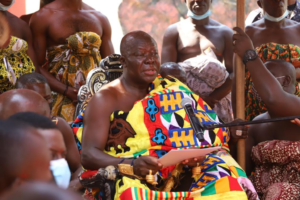Threat of food insecurity in Ghana worrying – Asantehene

The Asantehene, Otumfuo Osei Tutu II, has expressed worry over the near threat of food insecurity in the country, despite the abundance of fertile arable lands and enough intellectual capabilities in agriculture.
“It is unclear why the nation still struggled with total food independence.
“I find it difficult to accept why our country is struggling with food insecurity, when we have such vast arable lands, enough intellectual capacity in agriculture and adequate hands for farming,” Otumfuo Osei Tutu, stated at the opening of the maiden national development series, organised by the Graphic Communications Group Limited (GCGL), in Kumasi.
The Graphic National Development Series is an initiative of GCGL aimed at creating a platform to steer discussions of critical issues of national interest.
It was held on the theme: “Transforming Ghana’s Agriculture using Home-grown Solutions for Food Security.”
Otumfuo Osei Tutu, whose address was read on his behalf, pointed out that, food insecurity was a serious issue in Ghana and the recent projected figures threatened the nation.
It was, therefore, important for the country to do things differently to improve food production.
“The hard truth is, we must do things right to sanitize the agricultural space and achieve food sufficiency,” he stated.
According to the 2022 Annual Household Income Expenditure Survey, 49 per cent of Ghana’s population experienced food insecurity in the first quarter, and this meant that about 15 million people in the country are food insecure.
The Asantehene said although the second quarter survey saw a reduction of 42 per cent, which was about 13 million Ghanaians, the situation was still not a good as the phenomenon was even more prevalent in rural areas compared to urban areas.
For instance, while the Greater Accra Region recorded a prevalence of 27.2 per cent food insecurity, the Upper East region had 73.7 per cent.
The North-East recorded 65.6 percent, Upper West 61.8 per cent and Savannah had 58.8 percent.
Otumfuo Osei Tutu, said it was clear that these regions recorded double of food insecurity prevalence to that of the Greater Accra Region.
According to him, this had translated into another negative effect, citing the World Food Programme’s publication which stated hunger and malnutrition persisted primarily in the northern part of Ghana as well as many rural and peri-urban communities across the country.
“I believe why Northern Ghana bears the challenge is due to the scanty rainfall, what about Southern Ghana where the rain season happens twice a year,” he quizzed.
This one rainy season in the north, he noted, had also been affected by climate change such that it was no longer reliable and resulting in periods of prolong drought.
A report by the World Food Programme indicates that Ghana had only 21 percent of its farm lands under irrigation.
The Asantehene bemoaned the situation, saying that it was unsustainable if the country was to gain food sufficiency and indicated that “clearly as a country we are not doing something right and I hope there will be fruitful deliberations to enable Ghana to engage in productive agriculture all year round.
Mr Ato Afful, Managing Director of GCGL, said the company was collaborating across sectors of production, coordinating with stakeholders to fix production systems and make food production and processing competitive.
This would ensure efficient use of technology, nurture and promote the leadership with priorities to create wealth and consequently make home-grown solutions in food production and security attainable.
Source: GNA
